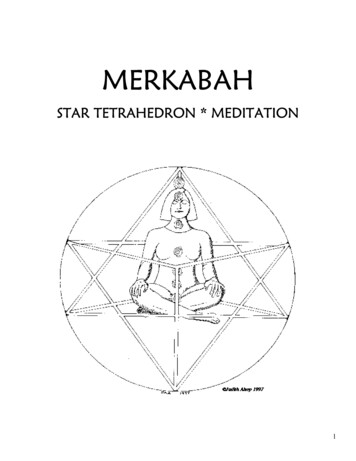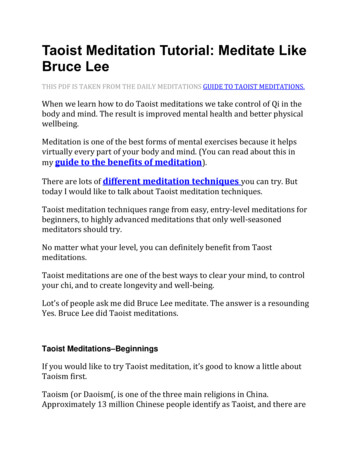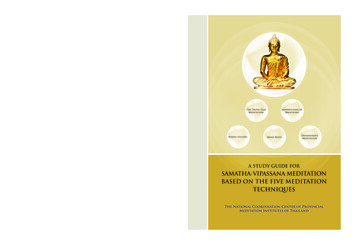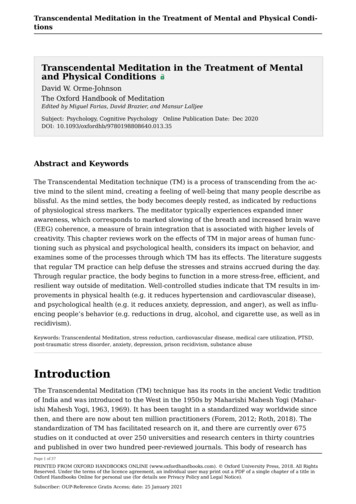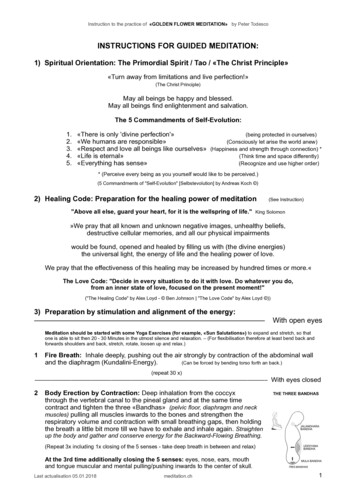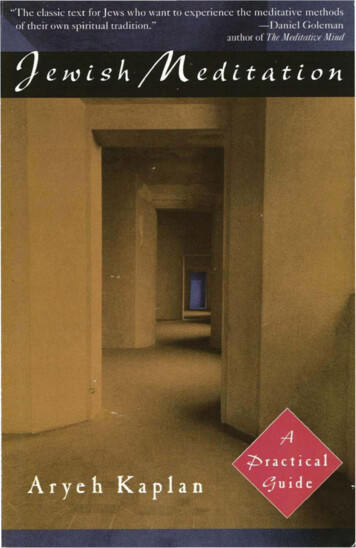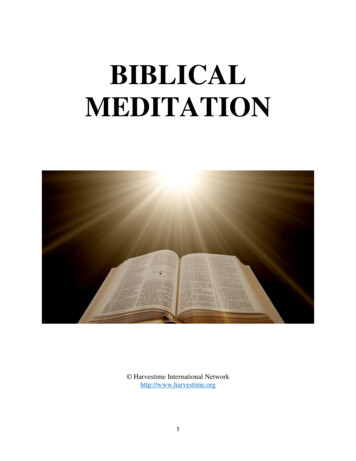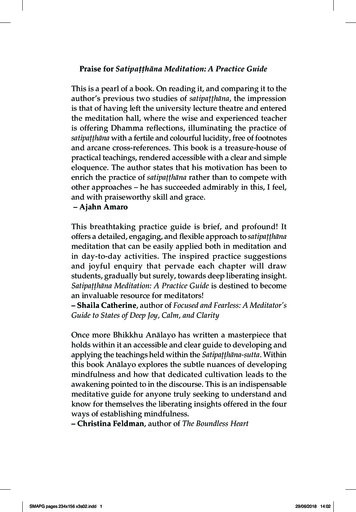
Transcription
V O L U M E 2 8 / N O . 2 I S S N : 1 0 5 0 -1 8 3 5 2 0 1 7Research Quarterlyadvancing science and pr omoting unders tanding of traum atic stressPublished by:National Center for PTSDVA Medical Center (116D)215 North Main StreetWhite River JunctionVermont 05009-0001 USA(802) 296-5132FAX (802) 296-5135Email: ncptsd@va.govAll issues of the PTSD ResearchQuarterly are available online at:www.ptsd.va.govEditorial Members:Editorial DirectorMatthew J. Friedman, MD, PhDBibliographic EditorMisty Carrillo, MLISManaging EditorHeather Smith, BA EdNational Center Divisions:ExecutiveWhite River Jct VTBehavioral ScienceBoston MADissemination and TrainingMenlo Park CAClinical NeurosciencesWest Haven CTEvaluationWest Haven CTPacific IslandsHonolulu HIWomen’s Health SciencesBoston MAMeditation-basedApproaches in theTreatment of PTSDEvidence-based psychotherapies (EBPs), such asProlonged Exposure and Cognitive ProcessingTherapy, are generally the first-line interventionsfor PTSD. Unfortunately, many Veterans still havediagnosable PTSD following EBPs (Steenkamp,Litz, Hoge, & Marmar, 2015) or prefer to try otherstrategies (Markowitz et al., 2016). Thus, there isa strong need for ways to supplement existingtreatments, reduce barriers to engagement in EBPsand provide alternatives for individuals who areaffected by PTSD. As meditation-based treatmentshave gained popularity, many practitioners andresearchers are incorporating them in the treatmentof PTSD (Libby, Pilver, & Desai, 2012). Multiple typesof meditation, which differ in philosophy and practice,have been applied clinically. This line of research isin its relative infancy, but initial evidence suggeststhat meditation-based approaches merit continuedinvestigation to evaluate their efficacy, mechanisms,and implementation within Department of VeteransAffairs (VA) settings.Recent reviews summarize the impact of meditationas applied to PTSD and other mental healthconditions. Hofmann, Grossman and Hinton (2011)reviewed evidence for the broadly beneficial effectsof meditation on mental health. They observed thatbrief instruction and practice are sufficient to producechange in some trials and that improvements mayoccur via improved positive affect. Hilton andcolleagues (2016) recently conducted a meta-analysisof meditation for PTSD. They observed thatmeditation trials generally led to small to moderatebetween-group effect sizes (standardized meandifferences of -0.41 and -0.34 respectively) forimprovements in PTSD and depressive symptomscompared to control conditions. Based on theseobserved positive effects on PTSD symptoms, theyconcluded that meditation is a promising adjunct tocurrent PTSD treatments. However, it requires furtherinvestigation as much of the current literature basehas insufficient methodological rigor. For instance,the authors noted that improving the descriptions ofAlexander M. Talkovsky, PhD and Ariel J. Lang, PhD, MPHCenter of Excellence for Stress and Mental Health,VA San Diego Healthcare Systemtreatment as usual (TAU) control conditions couldhelp elucidate the unique effects of meditation;analyzing adherence to protocols could help determinethe minimum effective and optimal doses; and moredetailed descriptions of the experience of therapists/practitioners could help understand how providerscould implement these practices. Finally, Rees (2011)reviewed the role of meditation in resilience programsfor military service members. This review found themost support for transcendental meditation (TM),followed by mindfulness and progressive musclerelaxation. Each was associated with a decrease inlikelihood of experiencing a range of physical andmental health problems as well as lower health careutilization and overall costs. These reviews suggestmeditation is promising as either an intervention orpreventative measure for management of stress/PTSDand point to a future research agenda in this area.Efficacy and EffectivenessA recent analysis of clinical data collected frommultiple VA sites provides information about theeffectiveness of meditation-based interventions. Thisstudy, which examined programs that have beenimplemented at six VA clinics, found moderate effectsizes for meditation programs above TAU in measuresof post-treatment PTSD symptoms and mindfulness(Heffner, Crean, & Kemp, 2016). On aggregate,between group effect sizes were moderate for PTSDsymptoms [-.32 on the Clinician Administered PTSDScale (CAPS), -.39 on the PTSD Checklist (PCL)]when compared to TAU. Effect sizes were also similaracross types of meditation (e.g., mindfulness- ormantram-based). Thus, meditation programs as theyare currently implemented appear to be of benefit toVeterans. Of note, two sites allowed participants tochoose whether they wanted to participate in theexperimental group or a comparison group, so resultsshould be interpreted accordingly.Continued on page 2Authors’ Addresses: Alexander M. Talkovsky, PhD and Ariel J. Lang, PhD, MPH are affiliated with the Center of Excellencefor Stress and Mental Health, VA San Diego Healthcare System (MC 116A), University of California San Diego, 3350 La JollaVillage Drive, San Diego, CA 92161. Email Address: Ariel.Lang@va.gov.
Continued from coverOne approach for which evidence of efficacy is growing is mantramrepetition, which involves silent repetition of a spiritual word or phraseas a coping tool. Bormann, Thorp, Wetherell, Golshan, and Lang(2013) conducted a randomized controlled trial (RCT) comparingmantram repetition plus TAU against TAU alone. Those completingmantram repetition were more likely to make meaningful improvementsin PTSD symptoms, and these effects appeared to occur largelythrough improvements in hyperarousal and spiritual well-being.A two-site RCT comparing mantram repetition to Present CenteredTherapy will be published shortly (VA Office of Research andDevelopment, 2015).Although mindfulness may be better conceptualized as a foundationalskill rather than as a meditation practice, mindfulness programs mayfunction similarly to formal meditation in terms of fostering bettermental health outcomes. For example, mindfulness was demonstratedto be a significant negative predictor of PTSD symptoms, depressivesymptoms, physical symptoms, and problematic alcohol use amongfirefighters, a population at high risk of trauma exposure (Smith et al.,2011). Polusny and colleagues (2015) completed an RCT comparingmindfulness-based stress reduction (MBSR) against PresentCentered Group Therapy (PCGT) among 116 Veterans. MBSR is acommonly used intervention, which aims to teach participants toapply nonjudgmental attention to the present moment as a means ofcoping with a variety of physical and mental health problems. Thosein the MBSR group evidenced modestly greater improvements inPTSD symptoms at post-treatment and 2-month follow-up, althoughthey were no more likely to remit; both the between- and within-groupdifferences were significant such that both groups improved and theMBSR improved to a greater extent. Building on the work of Kearney,McDermott, Malte, Martinez, and Simpson (2012), who foundmoderate to large within-group effect sizes for PTSD and depressionin a naturalistic study of MBSR, the Polusny trial is the only currentlypublished large controlled trial of MBSR with strong methodology(adequate power, follow-up assessments, blinded diagnosticassessors, measurement of treatment fidelity). One limitation of thisstudy was that it did not match the amount of clinician contact, sothat those in the MBSR group had more total contact with a therapist(Polusny et al., 2015). These studies generally support the utility ofMBSR for PTSD, although more rigorous studies are needed,especially with respect to non-Veterans. Furthermore, future studiesneed to follow patients over longer periods to determine thedurability of effects.Yoga is similarly not a formal meditation, but this practice has beenapplied to treat a variety of physical and emotional problems. Itsinclusion of mindfulness, controlled breathing, and postures potentiallyallows it to target mechanisms that may be relevant, such as reducingautonomic arousal (Seppälä et al., 2014). In one RCT testing itsefficacy, Veterans diagnosed with PTSD who completed SudarshanKriya yoga (a breathing-based practice) demonstrated reductions inPTSD and anxiety symptoms whereas a waitlist control group didnot (Seppälä et al., 2014). The yoga group not only improved instartle response, but reductions in startle response predictedreductions in hyperarousal symptoms at post-treatment and 1-yearfollow-up. Thus, breathing-based meditation practice may beparticularly useful for hyperarousal symptoms regardless of actualrespiratory changes. Jindani, Turner, and Khalsa (2015) comparedKundalini yoga, a practice including physical movement (asanas)and meditation, to a waitlist control group. They observed small tomoderate between-group effect sizes favoring yoga on measures ofPAGE 2PTSD symptoms, insomnia, perceived stress, positive and negativeaffect, resilience, stress, and anxiety. Finally, in an RCT comparingtrauma-informed yoga to a women’s health education controlcondition among women with chronic PTSD secondary to interpersonalviolence, those in the yoga group were more likely to remit,demonstrate greater PTSD symptom reduction and maintain theirgains over the short-term better than those in the control condition(van der Kolk et al., 2014). The authors posited that the greaterimprovements observed in the active condition were due to thephysical and interoceptive aspects of yoga, suggesting yoga mayimprove both distress tolerance and bodily awareness. At 18-monthfollow-up in this RCT, group membership no longer predicted outcome,but rather frequency of yoga practice was negatively related to PTSDand depression; these results suggest that continued practice maybe critical for maintenance of effects (Rhodes, Spinazzola, & van derKolk, 2016). As in these trials, it may be useful to modify yoga practiceto fit the needs of trauma survivors. Indeed, trials using “traumasensitive” yoga, which involves practice modifications to help traumasurvivors feel safer (i.e., invitatory language, good lighting, poses thatfacilitate feeling safe), appear more efficacious than those withoutsuch considerations (Wells, Lang, Schmalzl, Groessl, & Strauss, 2016).Other meditative approaches have been initially evaluated in PTSD.In a convenience sample, both TM and compassion meditationimproved psychological wellbeing, but frequency of practice wasrelated to improvements in self-reported well-being; there were nobetween-group differences (Schoormans & Nyklí ček, 2011). In aretrospective chart review, medication and service utilization weremeasured following a TM program for service members diagnosedwith PTSD or anxiety disorder NOS. Those who practiced TM weremore likely than demographically matched controls to decrease,cease, or stabilize their psychotropic medication use and to evidencedecreases in mental health symptoms at 1- and 3-month follow-up(Barnes, Monto, Williams, & Rigg, 2016). Similarly, TM demonstratedefficacy in a small, uncontrolled pilot study among OEF/OIF Veterans(Rosenthal, Grosswald, Ross, & Rosenthal, 2011). A large randomizedtrial comparing TM with Prolonged Exposure and wait list was recentlycompleted; findings will be available soon (United States Departmentof Defense, 2016). In an open pilot trial of loving-kindness meditation(LKM), a practice focused on the wish that others be happy, Kearneyand colleagues (2013) found that within-group effect sizes were largefor PTSD symptom reduction and moderate for depression improvementfrom pre-treatment to 3-month follow-up. A study of compassionmeditation (an open trial to refine the protocol followed by an RCTcomparing compassion meditation to relaxation training) aimingto add to the efficacy literature is also ongoing (Veterans MedicalResearch Foundation, 2015).Mechanisms of Meditation-based InterventionTo refine and optimally implement meditation-based approaches,understanding their cognitive, behavioral, and psychophysiologicalmechanisms is important. Potential mechanisms relate to changesin hyperarousal, intrusive cognitions, and endocrine markersof autonomic arousal (Wahbeh, Goodrich, Goy, & Oken, 2016).Accordingly, individuals completing a pilot of mindfulness-basedcognitive therapy demonstrated moderate reductions in PTSDsymptoms and moderate-to-large reductions in posttraumaticcognitions (King et al., 2013). Neuropsychological evidence suggestsmeditation improves the ability to modulate cognition, emotion, andbehavior (Hölzel et al., 2011). A trial of mindfulness-based exposuretherapy as compared to PCGT examined neural correlates ofmindfulness utilizing functional magnetic resonance imaging (fMRI).P T S D R E S E A R C H Q U A R T E R LY
Those in the mindfulness group demonstrated increased default moderesting-state functional connectivity to dorsolateral prefrontal corticalregions in the central executive network (King, Block, Sripada, Rauch,Giardino, et al., 2016). These changes may underlie the improvementsin attentional switching secondary to mindfulness training. Further, inan examination of neurological correlates of improvements in PTSDfollowing mindfulness-based exposure therapy, symptom reductionwas correlated with increased activity in brain areas associated withprocessing of social and emotional threats (King, Block, Sripada,Rauch, Porter, et al., 2016). Thus, meditation and mindfulness mayimprove PTSD symptoms by affecting neural circuitry implicated inattentional control and threat perception.Growing evidence also suggests that these approaches may affectautonomic nervous system activity. For example, meditation andMBSR have been associated with reduction in nonreactivity to innerexperience (Heffner, Crean, & Kemp, 2016; Stephenson, Simpson,Martinez, & Kearney, 2017). Increased parasympathetic anddecreased sympathetic nervous activity have been observed followingmeditation (Nesvold et al., 2012). Changes in stress responding arealso observable in neurological connectivity, suggesting changes alsooccur at the neuronal level (Taren et al., 2015). In an RCT comparing aprimary care mindfulness program to TAU in Veterans diagnosed withPTSD, those in the mindfulness group demonstrated reductions incortisol awakening response, a marker of stress responding, but thosecompleting TAU did not, thus suggesting mindfulness may exert itseffects by reducing neuroendocrine dysregulation associated withincreased sympathetic activity (Bergen-Cico, Possemato, & Pigeon,2014). Mantram meditation has been linked to reduced hyperarousalin particular (Bormann et al., 2013), suggesting that it may provide away for individuals to regulate autonomic arousal (Bormann et al.,2013; Lang et al., 2012).Another potentially important construct related to mindfulness ispositive emotional state. Increased positive affect may improve PTSDby building resilience, reducing dysphoria, or reducing stress reactivity(see Lang et al., 2012 for review). Hinton, Ojserkis, Jalal, Peou, andHofmann (2013) argued for the utility of mindfulness and meditationtechniques as an adjunct to CBT in trauma-exposed refugees andminorities. They cite psychological flexibility as a key emotionregulatory process targeted by meditation. Improving psychologicalflexibility is particularly important for refugees and minorities tonavigate between their own cultures and the dominant culture of theircurrent location. Indeed, Dick, Niles, Street, DiMartino, and Mitchell(2014) observed an association between improvements in psychologicalflexibility and improvements in PTSD symptoms following a yogaintervention. These studies identified a core process of third-waveinterventions as an important mechanism in building resilience andimproving PTSD symptoms.Increases in positive affect appear to be implicated in changesfollowing meditation. Kearney and colleagues (2014) observedincreases in positive emotions and decreases in negative emotionsfollowing 12 weeks of LKM. A related construct is self-compassion.Self-compassion involves self-kindness, or positive emotions towardsand wishes for the self. In addition, self-compassion supports holdingpainful thoughts and feelings in balanced awareness, rather allowingthem to determine one’s self-appraisal (Neff, 2003). Self-compassionis associated with positive affect and may be a marker of psychologicalwell-being (Neff, Rude, & Kirkpatrick, 2007). Mindfulness may alsocultivate self-compassion, potentially acting as an emotion regulationstrategy reducing PTSD symptoms by promoting positive emotionalityVOLUME 28/NO. 2 2017(Hölzel et al., 2011). Indeed, Kearney and colleagues (2013) foundthat change in self-compassion significantly mediated changes inPTSD and depression symptoms from pre-to-post treatment andfrom baseline to 3-month follow-up in their open trial of LKM. Otherhypothesized mechanisms include spirituality (Bormann, Liu, Thorp,& Lang, 2012). Although this line of research is still developing, thereis evidence meditation improves PTSD via mechanisms potentiallydistinct from other treatments.SummaryAlthough the body of research on meditation-based interventions forPTSD is relatively nascent, this type of intervention offers promise inaddressing PTSD. Several types of meditation-based approacheshave demonstrated efficacy in open trials, compared to alternativetreatments, and as an adjunct to other treatments. Further, themechanisms of change in meditation appear complementary to EBPs,offering alternatives for those with needs and preferences not met byfirst line treatments. Ultimately, its most important contribution may beas part of a recovery plan that addresses symptoms and restoresfunctioning through a variety of mechanisms.Future research should continue to examine the effectiveness ofmeditation-based approaches both as alternative and complementarystrategies to help determine their role in comprehensive treatmentprograms. Although meditation techniques are heterogeneous,examining these techniques in greater detail could help determinecommonalities among the approaches as well as ways in whichspecific techniques may make unique contributions. Greaterattention to mechanism of change, such as arousal, positive affector cognitive control, could highlight distinct benefits associated withmeditation and other types of PTSD treatment, raising the possibilityof personalizing care. Future research should seek to determine ifeffective programs can idiosyncratically package effective componentsor if they should rely on established protocols (Heffner, Crean, & Kemp,2016) as well as what dose and duration of practice is optimal (Langet al., 2012). High methodological rigor and common measurementtools will also be important in understanding the commonalities anddifferences among approaches.FEATURED ARTICLESBarnes, V. A., Monto, A., Williams, J. J., & Rigg, J. L. (2016). Impactof transcendental meditation on psychotropic medication useamong active duty military service members with anxiety and PTSD.Military Medicine, 181, 56-63. doi:10.7205/MILMED-D-14-00333The purpose of the study was to determine whether the regularpractice of Transcendental Meditation (TM) decreased the need forpsychotropic medications required for anxiety and post-traumaticstress disorder (PTSD) management and increased psychologicalwellbeing. The sample included 74 military Service Members withdocumented PTSD or anxiety disorder not otherwise specified(ADNOS), 37 that practiced TM and 37 that did not. At 1 month,83.7% of the TM group stabilized, decreased, or ceased medicationsand 10.8% increased medication dosage; compared with 59.4% ofcontrols that showed stabilizations, decreases, or cessations; and40.5% that increased medications (p 0.03). A similar pattern wasobserved after 2 (p 0.27), 3 (p 0.002), and 6 months (p 0.34).Notably, there was a 20.5% difference between groups in severity ofpsychological symptoms after 6 months, that is, the control groupPAGE 3
FEATURED ARTICLES continuedexperienced an increase in symptom severity compared with thegroup practicing TM. These findings provide insight into the benefitsof TM as a viable treatment modality in military treatment facilities forreducing PTSD and ADNOS psychological symptoms and associatedmedication use.Bergen-Cico, D., Possemato, K., & Pigeon, W. (2014). Reductions incortisol associated with primary care brief mindfulness programfor veterans with PTSD. Medical Care, 52(12), S25-S31. doi:10.1097/MLR.0000000000000224 Background: Patients with posttraumaticstress disorder (PTSD) have significant medical morbidity, which maybe mediated by hypothalamic pituitary axis (HPA) dysfunction andreflected in cortisol output. Many veterans with PTSD are hesitant toengage in trauma-focused exposure treatments; therefore briefer,non–exposure-based treatments are needed; one such promisingapproach is an abbreviated Primary Care brief Mindfulness Program(PCbMP). Objective: This study investigated the relationship betweendose-response to participation in a veterans PCbMP program anddiurnal cortisol. Cortisol reflects HPA function and PTSD is associatedwith HPA dysregulation. Research Design: Veterans with PTSD wereidentified in PC and randomly assigned to treatment as usual (TAU,n 21) or participation in brief 4-week Mindfulness Based StressReduction program (n 19). Subjects: Veterans (n 40;) (mean age,48 16 y; 90% men) with PTSD referred through their VA PC providerand randomly assigned to PCbMP or TAU. Measure: As an objectiveindicator of HPA function, salivary diurnal cortisol was measuredfrom samples collected across 2 consecutive days at baseline andfollow-up. Results: Analyses revealed that significant changes incortisol were associated with PCbMP treatment engagement anddosing (number of mindfulness program sessions completed).Veterans completing 4 mindfulness-based meditation sessionssignificantly reduced their cortisol awakening response (P 0.05);and had significant changes in cortisol area under the curve increasecompared with TAU participants (P 0.05). Results indicate thatPCbMP has a beneficial physiological impact on veterans with PTSDwith a minimum of 4 weeks of practice.Bormann, J. E., Thorp, S. R., Wetherell, J. L., Golshan, S., & Lang, A. J.(2013). Meditation-based mantram intervention for veterans withposttraumatic stress disorder: A randomized trial. PsychologicalTrauma: Theory, Research, Practice, and Policy, 5, 259-267. doi:10.1037/a0027522 Few complementary therapies for posttraumatic stressdisorder (PTSD) have been empirically tested. This study exploredthe efficacy of a portable, private meditation-based mantram (sacredword) intervention for veterans with chronic posttraumatic stressdisorder. A prospective, single-blind randomized clinical trial wasconducted with 146 outpatient veterans diagnosed with military-relatedPTSD. Subjects were randomly assigned to either (a) medication andcase management alone (i.e., treatment-as-usual [TAU]), or (b) TAUaugmented by a 6-week group mantram repetition program (MRP TAU). A total of 136 veterans (66 in MRP TAU; 70 in TAU) completedposttreatment assessments. An intent-to-treat analysis indicatedsignificantly greater symptom reductions in self-reported andclinician-rated PTSD symptoms in the MRP TAU compared withTAU alone. At posttreatment, 24% of MRP TAU subjects, comparedwith 12% TAU subjects, had clinically meaningful improvements inPTSD symptom severity. MRP TAU subjects also reported significantimprovements in depression, mental health status, and existentialspiritual well-being compared with TAU subjects. There was a 7%PAGE 4dropout rate in both treatment conditions. A meditation-based mantramrepetition intervention shows potential when used as an adjunct toTAU for mitigating chronic PTSD symptoms in veterans. Veteransmay seek this type of treatment because it is nonpharmacologicaland does not focus on trauma. It also has potential as a facilitator ofexposure-based therapy or to enhance spiritual well-being. Moreresearch is needed using a longitudinal effectiveness design with anactive comparison control group.Heffner, K. L., Crean, H. F., & Kemp, J. E. (2016). Meditation programsfor veterans with posttraumatic stress disorder: Aggregatefindings from a multi-site evaluation. Psychological Trauma: Theory,Research, Practice, and Policy, 8, 365-374. doi:10.1037/tra0000106Objectives: Interest in meditation to manage posttraumatic stressdisorder (PTSD) symptoms is increasing. Few studies have examinedthe effectiveness of meditation programs offered to Veterans withinDepartment of Veterans Affairs (VA) mental health services. The currentstudy addresses this gap using data from a multisite VA demonstrationproject. Method: Evaluation data collected at 6 VA sites (N 391Veterans) before and after a meditation program, and a treatment as-usual (TAU) program, were examined here using random effectsmeta-analyses. Site-specific and aggregate between group effectsizes comparing meditation programs to TAU were determinedfor PTSD severity measured by clinical interview and self-report.Additional outcomes included experiential avoidance and mindfulness.Results: In aggregate, analyses showed medium effect sizes formeditation programs compared to TAU for PTSD severity (clinicalinterview: effect size (ES) -0.32; self-report: ES -0.39). Similarlysized effects of meditation programs were found for overallmindfulness (ES 0.41) and 1 specific aspect of mindfulness,nonreactivity to inner experience (ES .37). Additional findingssuggested meditation type and program completion differenceseach moderated program effects. Conclusions: VA-sponsoredmeditation programs show promise for reducing PTSD severity inVeterans receiving mental health services. Where meditation trainingfits within mental health services, and for whom programs will be ofinterest and effective, require further clarification.Hilton, L., Maher, A. R., Colaiaco, B., Apaydin, E., Sorbero, M. E.,Booth, M., . . . Hempel, S. (2016). Meditation for posttraumaticstress: Systematic review and meta-analysis. Psychological Trauma:Theory, Research, Practice, and Policy. Advance Online Publication.doi:10.1037/tra0000180 Objective: We conducted a systematic reviewand meta-analysis that synthesized evidence from randomizedcontrolled trials of meditation interventions to provide estimates oftheir efficacy and safety in treating adults diagnosed with posttraumaticstress disorder (PTSD). This review was based on an establishedprotocol (PROSPERO: CRD42015025782) and is reported accordingto PRISMA guidelines. Outcomes of interest included PTSD symptoms,depression, anxiety, health-related quality of life, functional status,and adverse events. Method: Meta-analyses were conducted usingthe Hartung-Knapp-Sidik-Jonkman method for random-effects models.Quality of evidence was assessed using the Grade of RecommendationsAssessment, Development, and Evaluation (GRADE) approach.Results: In total, 10 trials on meditation interventions for PTSD with643 participants met inclusion criteria. Across interventions, adjunctivemeditation interventions of mindfulness-based stress reduction, yoga,and the mantram repetition program improve PTSD and depressionsymptoms compared with control groups, but the findings are basedP T S D R E S E A R C H Q U A R T E R LY
FEATURED ARTICLES continuedon low and moderate quality of evidence. Effects were positive butnot statistically significant for quality of life and anxiety, and nostudies addressed functional status. The variety of meditationintervention types, the short follow-up times, and the quality ofstudies limited analyses. No adverse events were reported inthe included studies; only half of the studies reported on safety.Conclusions: Meditation appears to be effective for PTSD anddepression symptoms, but in order to increase confidence infindings, more high-quality studies are needed on meditation asadjunctive treatment with PTSD-diagnosed participant sampleslarge enough to detect statistical differences in outcomes.Hinton, D. E., Ojserkis, R. A., Jalal, B., Peou, S., & Hofmann, S. G.(2013). Loving-kindness in the treatment of traumatized refugeesand minority groups: A typology of mindfulness and the nodalnetwork model of affect and affect regulation. Journal of ClinicalPsychology, 69, 817-828. doi:10.1002/jclp.22017 This article discusseshow loving-kindness can be used to treat traumatized refugees andminority groups, focusing on examples from our treatment, culturallyadapted cognitive-behavioral therapy (CA-CBT). To show how weintegrate loving-kindness with other mindfulness interventions andwhy loving-kindness should be an effective therapeutic technique,we present a typology of mindfulness states and the Nodal NetworkModel (NNM) of Affect and Affect Regulation. We argue thatmindfulness techniques such as loving-kindness are therapeuticfor refugees and minority populations because of their potential forincreasing emotional flexibility, decreasing rumination, serving asemotional regulation techniques, and forming part of a new adaptiveprocessing mode centered on psychological flexibility. We present acase to illustrate the clinical use of loving-kindness within the contextof CA-CBT.Hofmann, S. G., Grossman, P., & Hinton, D. E. (2011). Loving-kindnessand compassion meditation: Potential for psychologicalinterventions. Clinical Psychology Review, 31, 1126-1132. doi:10.1016/j.cpr.2011.07.003 Mindfulness-based meditation interventions havebecome increasingly popular in contemporary psychology. Otherclosely related meditation practices include loving-kindness meditation(LKM) and compassion meditation (CM), exercises oriented towardenhancing unconditional, positive emotional states of kindness andcompassion. This article provides a review of the background, thetechniques, and the empirical contemporary literature of
meditation trials generally led to small to moderate between-group effect sizes (standardized mean differences of -0.41 and -0.34 respectively) for improvements in PTSD and depressive symptoms compared to control conditions. Based on these observed positive effects on PTSD symptoms, they concluded t


